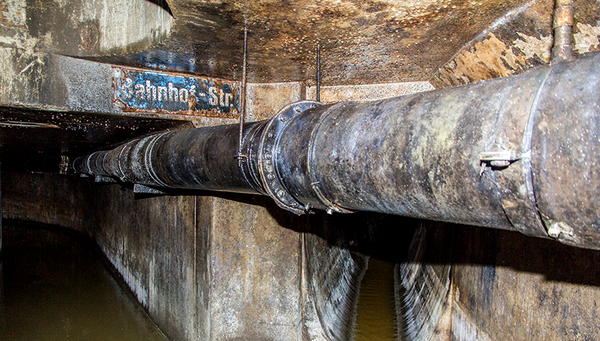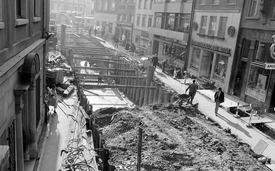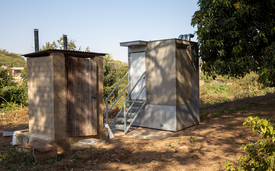Archive detail
Combined sewer system no longer sustainable
August 17, 2023 |
Kai Udert, Professor at the Institute of Environmental Engineering at ETH Zurich and Senior Scientist at Eawag agrees: "The fact that we dilute faeces, urine and slightly dirty grey water from bathrooms and kitchens with drinking water in order to transport them through the sewage system is actually absurd.” Wastewater is one of the last linear waste streams, he says. "Everything, whether it is dirty or clean, ends up in the same pot and is then disposed of. This is inefficient, and creates a fair number of problems that people have been trying to fix for years," the article quotes him as saying.
“Wastewater is one of the last linear waste streams”
Kai Udert
An expert in process engineering, Udert sees wastewater as a valuable resource. The combined sewer system wastes a great deal of water, energy and valuable nutrients that damage the environment if they are not recycled, he explains. Moreover, he says, the challenges are increasing. Factors like climate change, rapidly ageing infrastructure, growing population, increasing urbanisation and the pressing need for wastewater treatment plants to remove new micropollutants are all ramping up the pressure on wastewater management.
The renovation and renewal of storm drains in urban areas – here: Bregenz 1973 - involves complex construction projects that entail very high costs.
(Photo: Helmut Klapper, Vorarlberger Landesbibliothek; CC 4.0)
Plea for a paradigm shift
According to the Globe magazine article, Maurer and Udert advocate a paradigm shift in urban water management, towards more decentralised wastewater treatment systems based on a modular water infrastructure. The idea is to manage urban water more efficiently and effectively. "We see small, highly efficient, decentralised wastewater treatment plants as a supplementary alternative for treating wastewater locally and in a more flexible way," Maurer told the magazine. In fact, the development of these processes has already been underway for several years, spearheaded by the two researchers and others at Eawag.
Three guiding principles of resource-oriented and recyclable sanitation are central to Maurer’s and Udert’s work, namely: Material separation at source (no-mix), resource recovery, and decentralisation. If faeces and water were not mixed in the first place, it would be much easier to treat and reuse them. For instance, urine and excrement contain nutrients that could be used as fertilisers. And slightly dirty, grey water could be treated and used for numerous purposes, as well as serving as a heating source. The intention is to replace costly water conveyance in centrally organised pipe networks with smaller, decentralised systems.
Knowledge flowing in from Kenya
The article also features former Eawag researcher Elizabeth Tilley, now Professor of Global Health Engineering at ETH Zurich who, with her group, is developing affordable and socially acceptable approaches that protect human health and the environment. She also takes a decentralised approach: We desperately need decentralised solutions that are affordable, robust and easy to operate, Tilley says, citing the example of the biogas reactor currently undergoing trials by Lake Victoria in Kenya, which can treat faecal sludge and at the same time provide gas for cooking. Kai Udert emphasises that it is not only in the global south that such projects have a future: "The potential of the concepts we developed 15 years ago for use in poorer countries is now rapidly becoming apparent for use in Switzerland as well. We are benefiting from this knowledge already."
The “Autarky” toilet developed at Eawag (right), shown here in a field test in Durban, South Africa next to a dry toilet. Autarky treats the three separate streams - water, urine and faeces - in situ.
(Photo: Lucky Lugogwana)
Switzerland as a development and test market
According to the Globe, Maurer and Udert envisage modular sewage treatment plants being available in Swiss towns and villages in the near future. The Comix research project, jointly led by Maurer, has investigated the potential of a modular water management concept for Switzerland. The share of decentralised wastewater treatment plants is estimated to potentially increase from 2.5 per cent today to 50 per cent in the long term. This would give Switzerland an early opportunity to make its water infrastructure climate-compatible and to position itself as a development and test market for the modular water management solutions of the future, the article said. For this concept to become a reality, though, it would require concerted efforts from academia, industry and the public sector to demonstrate its feasibility in pilot projects and create an initial market.
Cover picture: Sewer under Zurich’s Bahnhofstrasse: The sewer conveys dirty water to the wastewater treatment plant, while the pipe drains rainwater away. (Photo: Max Maurer, Eawag, ETH Zurich)
This text is based on an article by Michael Keller in the ETH magazine GLOBE 2/2023: Focus "Water – Life-giving. Contested. Destructive."; this version was prepared by Volker Leise (in EUWID Wasser und Abwasser 28.2023) and Andri Bryner.



